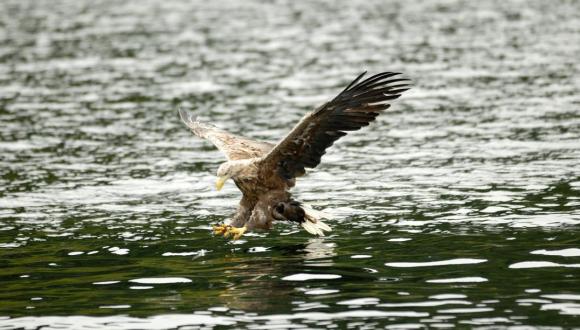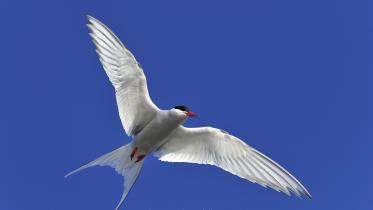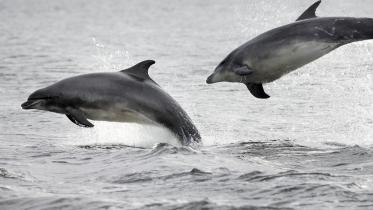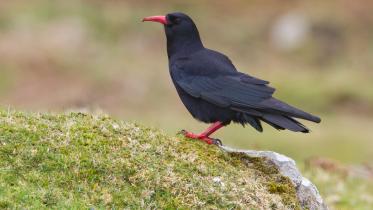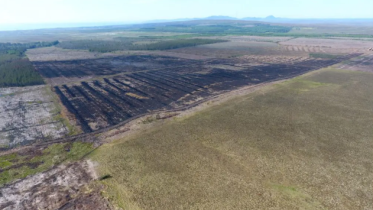White-tailed Eagle Action Plan - Questions and Answers
Published: 2019
The aim of this document is to help answer some of the questions raised by land managers and the general public about the birds themselves and the management work that is taking place.
The National White-tailed Eagle Action Plan is a working document developed and used by the National Sea Eagle Stakeholder Panel to progress work aimed at reducing the impacts of white-tailed eagles on sheep farming. It is a working document that has been signed up to and used by all the stakeholders on the National Panel and is being published now to help explain the background to the work taking place at various locations in the west of Scotland to a wider audience. A summary document setting out what has been done to date accompanies publication of the Action Plan.
This Q&A document has been prepared to accompany the Action Plan. The aim of this document is to help answer some of the questions raised by land managers and the general public about the birds themselves and the management work that is taking place.
Find out more
What are white-tailed eagles?
The white-tailed eagle, also known as the sea eagle, is the largest bird of prey in Britain and the fourth largest species of eagle in the world, with a wingspan of up to 2.4m. Adult birds have largely brown bodies, with a paler head and a short, white, wedge-shaped tail. Juvenile birds are normally a more uniform black/brown colour, with a more washed-out grey tail. These young birds take 4-5 years to reach adult plumage and breeding age. In flight, birds have extremely broad, almost rectangular wings, with deep ‘fingered’ tips.
Are they native to the UK?
Yes, the white-tailed eagle was once widespread across Britain and Ireland, before suffering sustained severe persecution throughout the middle ages and until the early 20th century when they were ultimately wiped-out in Britain. The last breeding pair was recorded on the Isle of Skye in 1916, and the last individual white-tailed eagle was shot on Shetland in 1918.
How have they returned to Scotland?
In 1975, a partnership between the RSPB and Nature Conservancy Council (SNH’s previous incarnation), supported by Government, initiated a reintroduction programme of whitetailed eagles to the west coast of Scotland. Between 1975-1985, 82 juvenile birds, from Norwegian donor stock, were released on Rum, with the first birds successfully breeding in Mull in 1983.
Two further phases of reintroduction took place in Wester Ross from 1993-98, and in Fife from 2007-2012.
Is their reintroduction ongoing?
No, the last phase of the white-tailed eagle reintroduction ended in 2012, and no birds have been released in Scotland since. Any population increases since 2012 have solely been due to successful breeding attempts. In 2019, are currently around 120-130 breeding pairs of white-tailed eagle in Scotland. Currently these are mostly in the west of the country and there are concentrations of territories on Mull, Skye, mainland Argyll and the Outer Hebrides.
Modelling work carried out in 2016 suggest a continued exponential population growth of white-tailed eagles in Scotland in the short-term. However, density-dependence in demographic rates would need to be considered in modelling population growth over the longer term.
What do they eat?
White-tailed eagles are generalist predators and scavengers, often eating the most abundant prey and available source in the immediate area. Seabirds, wildfowl (including geese), medium-sized mammals and fish are common prey items, with scavenged deer and sheep carrion playing a large part in their diet during winter months. Hedgehog and octopus are some of the more unusual prey items recorded in Scotland since reintroduction.
Do they predate sheep and lambs?
Yes, in some locations, white-tailed eagle do predate healthy sheep and lambs.
There have been a number of studies carried out to try to quantify the impacts of whitetailed eagle on sheep. Most notably there were two studies commissioned by Scottish Government, on Mull (Marquiss et.al., 2004) looking at the diet of white-tailed eagle and by SNH on the Gairloch peninsula (Simms et.al., 2010), which attempted to quantify the level of sheep scavenged and predated by white-tailed eagles. Since those studies, the population has increased in number and extended its range. More recently, a number of monitor crofts and farms have been studied to better understand the nature of the impacts in typical farming conditions across the white-tailed eagle range.
These previous studies concluded that not all white-tailed eagle nests contained lamb remains. Of those that did, most lambs found were taken as carrion. However, remains of dead lambs found in some nests showed signs that they may have been taken when live. Limitations on the scope of the studies meant that it is not possible to precisely quantify the effects of white-tailed eagle predation on lambs.
More recent work which has looked at the remains left in nests alongside post mortems carried out as part of SNH’s Sea Eagle Scheme and the use of nest cameras confirm that in some cases, white-tailed eagle are bringing freshly dead lamb carcasses to the nest and, in a number of cases, these lambs are likely to have been healthy when they were caught. Therefore, it is accepted that white-tailed eagle predation is a factor in some lamb losses.
White-tailed eagle diet studies have mostly focused on breeding birds and their nests because they forage so widely it is difficult to observe what they catch or scavenge other than what they bring to the nest. Also, the drive to catch live prey is accelerated by the need to feed chicks during the breeding season which also coincides with the lambing season in the West Highlands and Islands when most sheep impacts are reported. However, as the population has grown, so has the number of young non-breeding birds, which often gather in groups of around 5- 8 birds. Often these are the first birds to appear in new areas not previously frequented by white-tailed eagle. Crofters and farmers have reported sheep impacts thought to be from these younger birds also, but because they are not associated with nest sites, it is more difficult to accurately quantify the extent of their predation on sheep. Since the Mull and Gairloch studies, which only found evidence of attacks on lambs, there has been a significant increase in the number of incidents and locations where whitetailed eagles have been reported attacking and causing serious wounding, or killing, of adult sheep.
How does white-tailed eagle predation impact the viability of sheep farms?
On extensive hill sheep flocks, impacts can extend beyond simply the economic loss of a viable lamb destined for sale. Fewer ewe lambs result in a smaller pool of lambs from which replacements can be drawn for the hill flock. This then provides less choice over the quality of the replacements available with consequences for the flock’s breeding performance. It also affects the flock’s resilience to severe weather events, such as was experienced in spring 2018, and may also force the crofter or farmer to bring in replacement breeding stock from other areas, which may lack the acquired resistance to e.g., louping ill and other local diseases or parasites.
If all flock replacement ewes cannot be drawn from farm bred lambs then the alternative is to buy in replacements which are not often easily ‘hefted’ to the hill. Bought in ewes tend not to utilise hill grazings as efficiently as the hefted flock leading to poorer performance and, sometimes, long term habitat change on the hill as grazing pressures change. All these factors combined can contribute to a decline in the viability of a hill farm unit unless preventative measures are deployed.
Some of these preventative measures can also have impacts on the farms e.g reducing or ceasing to lamb on the hill (or at least put ewes and lambs out on the hill soon after lambing) can mean that in-bye grass reserves are exhausted much earlier, leading to higher forage costs. Crofters or farmers may have to switch breeds, e.g., to smaller, less economically profitable ones (or, conceivably, other way round – if not able to/wanting to use hill grazing any more). Also that rent paid for hill grazings may no longer be worthwhile or economically justifiable if they are not used in the same way.
SRUC have recently recruited a student to carry out a PhD study investigating causes of lamb loss on highland farms and crofts. This PhD will seek to a) define more accurately what is meant by the term blackloss, b) identify the underlying factors leading to blackloss, and c) quantify the part that white-tailed sea eagles play in the losses.
Why is this conflict happening here?
There are very few records of white-tailed eagles taking lambs where they overlap elsewhere in Europe; this problem appears to be almost unique to Scotland. While there is no concrete evidence for the reasons behind this, it is thought that it is partly due to the sea eagle breeding cycle coinciding with Scottish West coast lambing periods. This means the availability of lambs at the point when they are most vulnerable coincides with the whitetailed eagle need to provision their nest with food for young chicks. Often this can follow, or happen during, times when other prey or carrion isn’t as available due to severe weather periods or occur in areas where habitat condition is less than optimal for white-tailed eagles’ typical prey species.
What is being done in response to this conflict?
To support crofters and farmers in response to the lamb losses caused by white-tailed eagles, a partnership was formed between between Scottish Natural Heritage (SNH), National Farmers Union Scotland (NFUS), Scottish Crofters Federation (SCF), Forestry Commission Scotland (FCS), Scottish Government Rural Payments and Inspections Directorate (SGRPID), Scottish Rural Colleges (SRUC), Scottish Raptor Study Group (SRSG) and the Royal Society for the Protection of Birds Scotland (RSPB Scotland) to establish a Sea Eagle Management Scheme (SEMS) in 2014. The scheme is designed to extend support for livestock farmers and crofters who suffer impacts across the breeding range of white-tailed eagles.
How does the Sea Eagle Management Scheme support crofters and farmers?
Call-off contractors are employed by the Sea Eagle management scheme to:
- Investigate white-tailed eagle activity on or near the croft or farm.
- Gather evidence of white-tailed eagle impacts and record any livestock losses due to white-tailed eagles or other causes.
- Advising on measures to mitigate against white-tailed eagle impacts.
- Arranging to lend equipment designed to deter white-tailed eagles or mitigate their impacts.
- Recommend support for longer-term management measures to be carried out by the livestock manager.
Up to £1500 per year (dependent on holding size) is available under the current scheme (under review at present) for affected land managers to carry out agreed livestock management designed to mitigate white-tailed eagle impacts.
The scheme is overseen by local stakeholder groups and there are currently two groups operating: one in the Argyll and Lochaber area, and the other in Skye and Lochalsh. Representatives from local stakeholder groups are invited to feedback to a national stakeholder group comprising representatives of all the organisations involved in the whitetailed eagle partnership.
What are the roles of the local and national stakeholder group?
Stakeholder groups are key in the management of the white-tailed eagle management scheme. Both local and national stakeholder groups contain representatives from SNH, NFUS, RSPB Scotland, FCS, SCF, SGRPID and SRUC.
Local stakeholder groups agree the management measures being deployed within the area, as well as the trials of non-lethal white-tailed eagle management being trialled on monitor farms. They also provide an opportunity for those affected by white-tailed eagles to engage with local issues caused by white-tailed eagles, and share good management practices or techniques that have been found to be successful in the area. Feedback from the local stakeholder groups is then fed into the national stakeholder group.
The national stakeholder group is tasked with listening to and acting on the feedback provided by local stakeholder groups. The national group is also tasked with investigating new adaptive management methods, evaluating their potential, and putting into place actions for management measures to mitigate the impacts of white-tailed eagles.
What role do the call-off contractors play?
Call-off contractors provide a link between crofters and farmers and members of the stakeholder groups. They are all experts in white-tailed eagle behaviour, and also have knowledge of Scottish livestock crofting and farming. Call-off contractors provide support to scheme applicants through one-to-one meetings where they assess the level of white-tailed eagle activity in the area, and impacts they may be having on livestock. They can then recommend ways of adapting sheep management to reduce the possibility of predation, and advise on ways in which the scheme can support them in implementing the recommended management measures.
How can I join the Sea Eagle Management Scheme (SEMS)?
If you are experiencing white-tailed eagle impacts and would like to participate in the scheme, you should complete a ‘Register of Interest’ form, which can be obtained either by:
- Visiting Sea Eagle Management Scheme documents
- Request by email [email protected]
- Contact your local SNH office
Is there anything else being trialled beyond sheep management?
SNH are working with a group of monitor farms and crofts to trial measures to deter whitetailed eagles from frequenting areas where they are having an impact on sheep. The sites were selected to represent the range of farming circumstances involved, and where the impacts are clearly demonstrated, and also where the farmers and crofters have been willing to test new measures despite their losses. . The trials have so far investigated the use of scaring devices, manipulation of nest sites and diversionary feeding under licensed conditions.
The diversionary feeding trials involve providing an alternative food source during the period of peak vulnerability of lambs to predation. This is not to be confused with supplementary feeding, and is not designed to influence the success of the birds. If the food is taken by the nesting pair then it has been found to reduce the propensity of a pair of birds to frequent a nearby lambing park.
In one instance nest trees close to a hill lambing park have been removed to dissuade the birds from nesting close to the park. Whilst in this instance the tree removal did not prevent the birds from re-nesting close by, the lessons learned from this trial are being used to try the technique again in combination with other measures to improve its chance of success.
We continue to explore the scenarios where these measures successfully deter white-tailed eagles from sheep, and also look at additional innovative measures to try and promote a sustainable co-existence with sheep farmers and crofters. It is planned to roll out some of these measures from 2019 onwards under the Sea Eagle Management Scheme.
If white-tailed eagles are less likely to take sheep when they have access to wild prey, how can I encourage more wild prey sources on my land?
The Agri-environment Climate Scheme (AECS) scheme under the Scottish Rural Development Programme (SRDP) offers a range of habitat management options designed to enhance or restore habitat condition including moorland management. Whilst not directly targeted at white-tailed eagles or their prey, this can offer an opportunity to improve habitat for these species through support for changing grazing management etc.
As part of their action plan the white-tailed eagle stakeholder group is looking at ways at which future farm support schemes can contribute to this aspect of white-tailed eagle management.
Is population control currently an option?
White-tailed eagles are protected under the Wildlife and Countryside Act 1981, meaning that it is an offence to intentionally or recklessly, among other actions, harass, take, injure or kill a white-tailed eagle or to take, damage or destroy its nest eggs or young. Nests are also protected all year.
The Wildlife and Countryside Act allows licences to be granted for actions that would otherwise be an offence for specific purposes, including: ‘preventing serious damage to livestock, foodstuffs for livestock, crops, vegetables, fruit, growing timber, fisheries or inland waters’.
The white-tailed eagle population in Scotland is increasing both in number of birds and range. In the densest parts of their territory, population models indicate that their population could withstand the removal of a small number of individuals, and continue to grow.
However, lethal options are not currently being considered. The national stakeholder group remain committed to trialling non-lethal adaptive management to minimise the impacts white-tailed eagles are having, and promote sustainable co-existence between white-tailed eagles and crofters and farmers, and to facilitate the continued range expansion of whitetailed eagles.
Is the manipulation of white-tailed eagle behaviour allowed when the birds are a protected species?
SNH can issue a license to carry out measures that would otherwise be considered an offence under the Wildlife and Countryside Act 1981. As the licensing authority SNH have to be satisfied that the following tests have been met.
- Is serious damage being, or likely to be, caused by white-tailed eagles at the site?
- Have all other reasonable non-lethal scaring measures either been tried and found to be ineffective; or are impractical; or are unlikely to work at the site?
- Is it reasonable to consider that the proposed licensed activity will reduce, or prevent from increasing, the level of damage?
Licenses can also be issued for research purposes under the Wildlife and Countryside Act 1981 and a research license has been issued to trial the manipulation of sea eagle nests as part of the ongoing monitor farm trials and to explore the level of evidence required to meet the three licensing tests. These trials are ongoing.
Can white-tailed eagles benefit tourism?
Yes. There have been studies done on Mull and Skye that conclude that, in some locations, tourism connected to white-tailed eagles and wider eco-tourism, of which white-tailed eagles can be a major factor, can be beneficial to the local economy.
Disclaimer: Scottish Natural Heritage (SNH) has changed its name to NatureScot as of the 24th August 2020.
At the time of publishing, this document may still refer to Scottish Natural Heritage (SNH) and include the original branding. It may also contain broken links to the old domain.
If you have any issues accessing this document please contact us via our feedback form.
